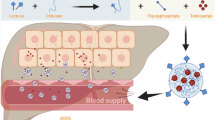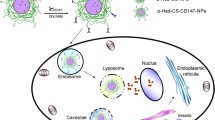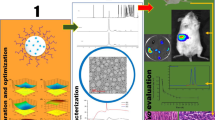Abstract
Vector plays an important role in hepatic targeted drug delivery system. In this study, a novel material as a liver targeting vector, dual-ligand modified chitosan (GCGA) composed of chitosan (CTS), glycyrrhetinic acid (GA) and lactobionic acid (LA), was designed and synthesized by an orthogonal experiment with two-step synthesis under mild conditions. The synthesized final product was characterized and confirmed by FTIR and 1H-NMR spectroscopy, and DS of GA and LA in CTS were measured to be 13.77 and 16.74 mol% using 1H-NMR, respectively. The cytotoxicity of CTS and GCGA was concentration dependent which was inverse proportion to the cell viability by MTT assay using L929 cell line, and inhibitory concentration 50% (IC50) was 0.2 mg/ml for GCGA. The in vitro targeting efficiency and the in vitro cellular uptake were investigated. Compared with CTS NPs and GA-CTS NPs, GCGA NPs showed good cell specificity to BEL-7402 cells via the dual-ligand-receptor-mediated recognition, leading to a higher affinity to BEL-7402 cells. The results suggested that GCGA described here has the potential to be used as an effective vector for hepatic targeted drug therapy.










Similar content being viewed by others
References
Dufour JF, Johnson P. Liver cancer: from molecular pathogenesis to new therapies: summary of the EASL single topic conference. J Hepatol. 2010;52:296–304.
Nguyen TH, Ferry N. Liver gene therapy: advances and hurdles. Gene Ther. 2004;11:S76–84.
Kinoshita H, Watanabe A, Hisayasu S, Suzuki S, Shimada T. Targeted gene delivery to selected liver segments via isolated hepatic perfusion. J Surg Res. 2010;160:47–51.
Sedlacek HH. Pharmacological aspects of targeting cancer gene therapy to endothelial cells. Crit Rev Oncol Hemat. 2001;37:169–215.
Muzzarelli C, Muzzarelli RAA. Natural and artificial chitosan-inorganic composites. J Inorg Biochem. 2002;92:89–94.
Hamman JH. Chitosan based polyelectrolyte complexes as potential carrier materials in drug delivery systems. Mar Drugs. 2010;8:1305–22.
Ashwell G, Harford J. Carbohydrate-specific receptors of the liver. Annu Rev Biochem. 1982;51:531–54.
Groman EV, Enriquez PM, Jung C, Josephson L. Arabinogalactan for hepatic drug delivery. Bioconj Chem. 1994;5:547–56.
Bom HS, Min JJ, Jeong HJ. Molecular nuclear imaging for targeting and trafficking. Nucl Eng Technol. 2006;38:399–404.
Schwartz AL, Rup D, Lodish HF. Difficulties in the quantification of asialoglycoprotein receptors on the rat hepatocyte. J Biol Chem. 1980;255:9033–6.
Baenziger JU, Fiete D. Galactose and N-acetylgalactosamine-specific endocytosis of glycopeptides by isolated rat hepatocytes. Cell. 1980;22:611–20.
Negishi M, Irie A, Nagata N, Ichikawa A. Specific binding of glycyrrhetinic acid to the rat liver membrane. Biochim Biophys Acta. 1991;1066:77–82.
Ishida S, Sakiya Y, Ichikawa T, Taira Z. Uptake of glycyrrhizin by isolated rat hepatocytes. Biol Pharm Bull. 1993;16:293–7.
Obrian CA, Ward NE, Vogel VG. Inhibition of protein kinase C by the 12-O-tetradecanoylphorbol-13-acetate antagonist glycyrrhetic acid. Cancer Lett. 1990;49:9–12.
Yang L, Yang Z, Hu J, Huang S, Deng X, Miao X. Significance of the expression of glutamate decarboxylase 65 and protein kinase C in primary hepatocarcinoma tissues. Chin J Gen Surg. 2003;12:590–3.
Chung TW, Yang J, Akaike T, Cho KY, Nah JW, Kim SI, Cho CS. Preparation of alginate/galactosylated chitosan scaffold for hepatocyte attachment. Biomaterials. 2002;23:2827–34.
Zheng YL, Wu Y, Yang WL, Wang CC, Fu SK, Shen XZ. Preparation, characterization, and drug release in vitro of chitosan-glycyrrhetic acid nanoparticles. J Pharm Sci. 2006;95:181–91.
Feng ZQ, Chu XH, Huang NP, Wang T, Wang YC, Shi XL, Ding YT, Gu ZZ. The effect of nanofibrous galactosylated chitosan scaffolds on the formation of rat primary hepatocyte aggregates and the maintenance of liver function. Biomaterials. 2009;30:2753–63.
Lu B, Wu DQ, Zheng H, Quan CY, Zhang XZ, Zhuo RX. Galactosyl conjugated N-succinyl-chitosan-graft-polyethylenimine for targeting gene transfer. Mol BioSyst. 2010;6:2529–38.
Song BF, Zhang W, Peng R, Huang J, Me T, Li Y, Jiang Q, Gao R. Synthesis and cell activity of novel galactosylated chitosan as a gene carrier. Coll Surface B. 2009;70:181–6.
Tian Q, Wang XH, Wang W, Zhang CN, Liu YA, Yuan Z. Insight into glycyrrhetinic acid: the role of the hydroxyl group on liver targeting. Int J Pharm. 2010;400:153–7.
Cheng MR, Li Q, Wan T, Hong XW, Chen HX, He B, Wu JB, Zhou RJ, et al. Synthesis and efficient hepatocyte targeting of galactosylated chitosan as a gene carrier in vitro and in vivo. J Biomed Mater Res B Appl Biomater. 2011;99:70–80.
Stockert RJ, Morell AG. Hepatic binding protein: the galactose-specific receptor of mammalian hepatocytes. Hepatology. 1983;3:750–7.
Tian Q, Zhang CN, Wang XH, Wang W, Huang W, Cha RT, Yuan Z, Tang H, et al. Glycyrrhetinic acid-modified chitosan/poly(ethylene glycol) nanoparticles for liver-targeted delivery. Biomaterials. 2010;31:4748–56.
Mi FL, Wu YY, Chiu YL, Chen MC, Suang HW, Yu SH, Shyu SS, Huang MF. Synthesis of a novel glycoconjugated chitosan and preparation of its derived nanoparticles for targeting HepG2 cells. Biomacromolecules. 2007;8:892–8.
Sam S, Touahir L, Andresa JS, Allongue P, Chazalviel JN, Gouget-Laemmel AC, et al. Semiquantitative study of the EDC/NHS activation of acid terminal groups at modified porous silicon surfaces. Langmuir. 2010;26:809–14.
Kalyan S, Sharma PK, Garg VK, Kumar JV, Varshney J. Recent advancement in chitosan based formulations and its pharmaceutical application. Der Pharmacia Sinica. 2010;1:195–210.
Chen G, Mi J, Wu XH, Luo CL, Li JB, Tang YX, Li J. Structural features and bioactivities of the chitosan. Int J Biol Macromol. 2011;49:543–7.
Lu B, Wang CF, Wu DQ, Li C, Zhang XZ, Zhuo RX. Chitosan based oligoamine polymers: synthesis, characterization, and gene delivery. J Control Release. 2009;137:54–62.
Agnihotri SA, Mallikarjuna NN, Aminabhavi TM. Recent advances on chitosan-based micro- and nanoparticles in drug delivery. J Control Release. 2004;100:5–28.
Wu L, Zhang J, Watanabe WW. Physical and chemical stability of drug nanoparticles. Adv Drug Deliv Rev. 2011;63:456–69.
Acknowledgment
We would like to thank the financial support from Self-determined and Innovate Research Funds of Wut (NO. 2010-ZY-CL-042).
Author information
Authors and Affiliations
Corresponding authors
Additional information
Houxiang Chen and Min Li contributions by the two collaborating parties are equal.
Rights and permissions
About this article
Cite this article
Chen, H., Li, M., Wan, T. et al. Design and synthesis of dual-ligand modified chitosan as a liver targeting vector. J Mater Sci: Mater Med 23, 431–441 (2012). https://doi.org/10.1007/s10856-011-4494-1
Received:
Accepted:
Published:
Issue Date:
DOI: https://doi.org/10.1007/s10856-011-4494-1




